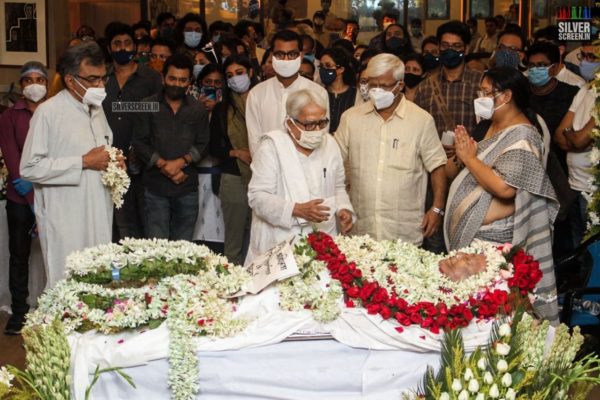Veteran actor Soumitra Chatterjee died on November 15 due to complications related to Covid-19 at a private hospital in Kolkata.
Soon after doctors declared the 85-year-old actor dead, West Bengal Chief Minister Mamata Banerjee rushed to Belle Vue Hospital, where he was undergoing treatment, and visited his family members. Addressing media persons, she announced that Chatterjee’s body would be kept at several points in the city for people to pay their last respects to the actor.
Chatterjee’s body was first taken to his residence at Golf Green area of Kolkata and was then taken to Technician’s Studio in Tollygunge area, the nerve-centre of the Bengali film industry, for film technicians to pay their respects. His body was then kept for two hours at the Rabindra Sadan cultural complex, where the public was allowed to pay their last respects. Several members of the Bengali film and television industry, as well as political leaders paid their respects to Chatterjee at Rabindra Sadan. People turned up in large numbers to bid farewell to their favourite Feluda.


From Rabindra Sadan, Chatterjee’s body was taken to Keoratola crematorium for his funeral. Despite Covid-19 regulations in place, hundreds of people participated in the procession that led Chatterjee’s body to the crematorium from Rabindra Sadan.
Chatterjee, who identified himself as a Marxist, never shied away from making bold political statements and was open about his political leanings towards the then ruling CPI(M) government in Bengal. He even worked on films that had strong political undertones in the plot lines. In 2007, when the state’s intellectuals were voicing their opinions against the then CPI(M) government’s land acquisition in Nandigram, Chatterjee stood by the state government, despite facing criticisms. An open critic of Rightist politics, he had publicly criticised Modi for introducing the Citizenship Amendment Act. Earlier this year, the thespian had penned an article for the Durga Puja edition of Ganashakti, the Bengali mouthpiece of the CPI(M), titled Ekhono Biswas Kori Bamponthai Bikolpo (I sill believe Leftist ideology is the alternative).
In a fitting farewell and an unprecedented gesture, his funeral procession saw the participation of leaders from both the Left Front as well as the Trinamool Congress. While Trinamool Congress chief Mamata Banerjee led the procession; Left Front chairperson Biman Bose, CPI(M) state secretary Surjyakanta Mishra and CPI(M) leader and MLA Sujan Chakraborty walked along with the crowds to pay their last tributes to their comrade.
As the procession walked along the streets of Kolkata, people sung songs composed by Rabindranath Tagore to celebrate Chatterjee and the expansive body of films he had worked on. As the procession passed by, many people stood silently, holding candles in honour of Chatterjee. People carried banners and photos of Chatterjee as they walked behind the hearse carrying Chatterjee’s body.

As per the chief minister’s announcement, Chatterjee was given full state honours at his funeral. Besides Chatterjee’s family, his funeral was attended by the chief minister, Left Front leaders Bose, Mishra, Chakraborty, and several film personalities. He was honoured with a gun salute by the Kolkata Police.
Over a six-decade-long career, Chatterjee has acted in almost 200 films and has worked closely with master filmmaker Satyajit Ray. Out of the 36 films that Ray made, 14 of them were with Chatterjee. Chatterjee debuted in Ray’s Apur Sansar (1959), the third film in the Apu Trilogy and went on to act in iconic films like the Feluda series, Devi (1960), Charulata (1964), Aranyer Din Ratri (1970), Ghare Baire (1984), and many more. On the advice of Ray, he took up commercial film projects and worked on some memorable films, at a time when Uttam Kumar was the reigning star of commercial Bengali cinema.
As news of his death spread, many news organisations across the world recalled Chatterjee’s iconic performances and penned tributes in honour of the late actor.
Sharing photos by Nemai Ghosh, a renowned photographer who worked with Ray for over two decades, BBC quoted an excerpt from an interview with film critic and biographer Marie Seton.
“I didn’t know what to do when Mr Ray first asked me. I didn’t know what was the real difference between stage and screen acting. I was afraid I’d overact,” he told Marie Seton.
“His chief asset was the natural sensitivity of his appearance,” Seton wrote of the actor.
Calling the veteran actor a “frequent Satyajit Ray collaborator”, Variety reported that the actor had 10 films ready for release at the time of his death and he continued his association with theatre till the end.
Recommended
“Soumitra Chatterjee is an ‘idea’ which is slowly fading away amongst us. The all encompassing persona of a Renaissance man,” Suman Ghosh, who directed Chatterjee in Podokkhep told Variety. “He had an intensely exploratory mind which wanted to enquire and explore many facets of life, which revealed through his writings, poetry, theater and of course cinema. I hope he is remembered beyond just being an internationally renowned actor.”
Elaborating on the actor’s preference to work solely in Bengali cinema, AP wrote: “Despite his immense popularity in Bengali-language cinema, Chatterjee stayed away from Bollywood. But for 90 million Bengalis, he was a cultural icon and an unforgettable star.”
In 1999, Chatterjee became the only Indian film personality to be conferred with the Ordre des Arts et des Lettres, France’s highest award for artists. In 2017, he was honoured with France’s highest civilian award, the Chevalier of Legion of Honour.
Expressing his grief, Ambassador of France Emmanuel Lenain took to Twitter to offer his condolences.
Deeply saddened to learn legendary actor Soumitra Chatterjee has passed away. A versatile artist, he earned the world’s admiration and many awards, including 🇫🇷 Order of Arts and Letters & Legion of Honour. My heartfelt condolences to his family and fans. pic.twitter.com/cuRW3REF3k
— Emmanuel Lenain (@FranceinIndia) November 15, 2020



